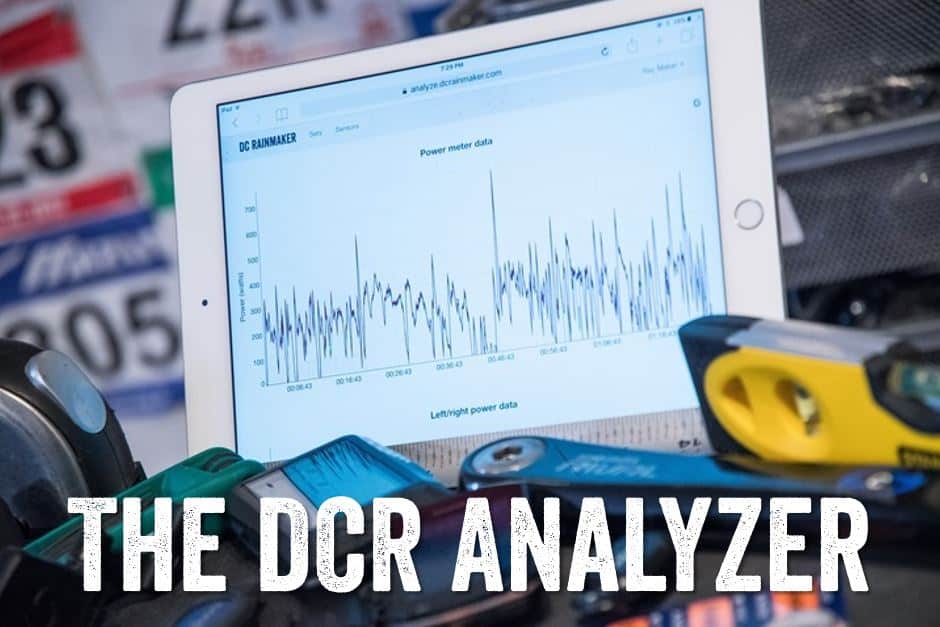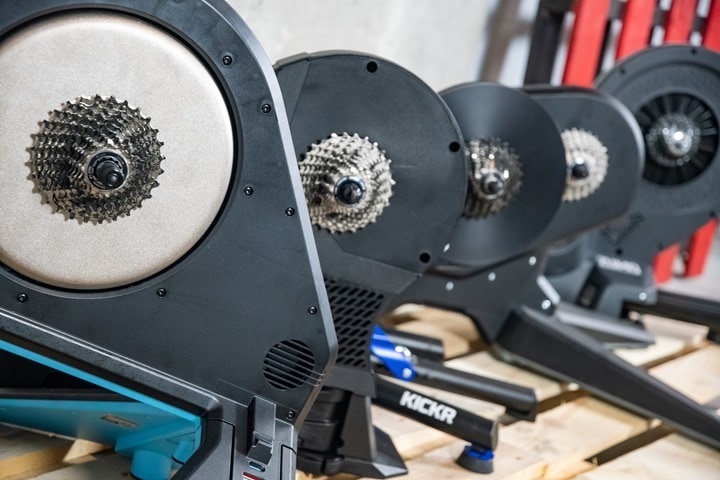Heads up – Massive Sports Tech Holiday Deals List is Live!!! The Garmin Fenix 8 is $250 off (even the Fenix 8 Pro is $100 off!), the Apple Watch Ultra 3 is on sale, the Garmin inReach Mini 2 is $249, the GoPro Hero 13 Black, DJI NEO, and a ton of other brands/deals, including Wahoo, Oura, Whoop, Polar, Samsung, Google, and more than 100 sports tech deals here!
I’m DC RAINMAKER…

I swim, bike and run. Then, I come here and write about my adventures. It’s as simple as that. Most of the time. If you’re new around these parts, here’s the long version of my story.

You'll support the site, and get ad-free DCR! Plus, you'll be more awesome. Click above for all the details. Oh, and you can sign-up for the newsletter here!
Here’s how to save!
Wanna save some cash and support the site? These companies help support the site! With Backcountry.com or Competitive Cyclist with either the coupon code DCRAINMAKER for first time users saving 15% on applicable products.
You can also pick-up tons of gear at REI via these links, which is a long-time supporter as well:Alternatively, for everything else on the planet, simply buy your goods from Amazon via the link below and I get a tiny bit back as an Amazon Associate. No cost to you, easy as pie!
You can use the above link for any Amazon country and it (should) automatically redirect to your local Amazon site.
While I don't partner with many companies, there's a few that I love, and support the site. Full details!

Want to compare the features of each product, down to the nitty-gritty? No problem, the product comparison data is constantly updated with new products and new features added to old products!

Wanna create comparison chart graphs just like I do for GPS, heart rate, power meters and more? No problem, here's the platform I use - you can too!

Think my written reviews are deep? You should check out my videos. I take things to a whole new level of interactive depth!

Smart Trainers Buyers Guide: Looking at a smart trainer this winter? I cover all the units to buy (and avoid) for indoor training. The good, the bad, and the ugly.
-
Check out my weekly podcast - with DesFit, which is packed with both gadget and non-gadget goodness!

Get all your awesome DC Rainmaker gear here!
FAQ’s
I have built an extensive list of my most frequently asked questions. Below are the most popular.
- Do you have a privacy policy posted?
- Why haven’t you yet released a review for XYZ product you mentioned months ago?
- Will you test our product before release?
- Are you willing to review or test beta products?
- Which trainer should I buy?
- Which GPS watch should I buy?
- I’m headed to Paris – what do you recommend for training or sightseeing?
- I’m headed to Washington DC – what do you recommend for training?
- I’m from out of the country and will be visiting the US, what’s the best triathlon shop in city XYZ?
- What kind of camera do you use?
-
5 Easy Steps To The Site
In Depth Product Reviews
You probably stumbled upon here looking for a review of a sports gadget. If you’re trying to decide which unit to buy – check out my in-depth reviews section. Some reviews are over 60 pages long when printed out, with hundreds of photos! I aim to leave no stone unturned.
Read My Sports Gadget Recommendations.
Here’s my most recent GPS watch guide here, and cycling GPS computers here. Plus there are smart trainers here, all in these guides cover almost every category of sports gadgets out there. Looking for the equipment I use day-to-day? I also just put together my complete ‘Gear I Use’ equipment list, from swim to bike to run and everything in between (plus a few extra things). And to compliment that, here’s The Girl’s (my wife’s) list. Enjoy, and thanks for stopping by!
Have some fun in the travel section.
I travel a fair bit, both for work and for fun. Here’s a bunch of random trip reports and daily trip-logs that I’ve put together and posted. I’ve sorted it all by world geography, in an attempt to make it easy to figure out where I’ve been.
My Photography Gear: The Cameras/Drones/Action Cams I Use Daily
The most common question I receive outside of the “what’s the best GPS watch for me” variant, are photography-esq based. So in efforts to combat the amount of emails I need to sort through on a daily basis, I’ve complied this “My Photography Gear” post for your curious minds (including drones & action cams!)! It’s a nice break from the day-to-day sports-tech talk, and I hope you get something out of it!
The Swim/Bike/Run Gear I Use List
Many readers stumble into my website in search of information on the latest and greatest sports tech products. But at the end of the day, you might just be wondering “What does Ray use when not testing new products?”. So here is the most up to date list of products I like and fit the bill for me and my training needs best! DC Rainmaker 2024 swim, bike, run, and general gear list. But wait, are you a female and feel like these things might not apply to you? If that’s the case (but certainly not saying my choices aren’t good for women), and you just want to see a different gear junkies “picks”, check out The Girl’s Gear Guide too.


















No more issue if you move your Mini 5 Pro from C0 to C1 class as C1 allows for drone under 900g.
Totally, at least in the EU. But then you need to go complete the licensing test. ;)
And same goes for Canada. I haven’t looked super closely at the nuances of the UK.
There is no real penalty in the EU from moving from C0 to C1, as both allow operations in open category A1. Operating a DJI mini requires operator registration anyway as it has a camera and, while operating a C1 drone requires going through an online training and exam, I’d argue this should be recommended anyway.
The main technical difference between C0 and C1 drones, other than weight, is that C1 drones need to have remote Id. Since DJI offers the possibly to update the Mini 5 Pro to C1, I guess it is remote Id capable.
What is strange is that DJI felt the need to play with the limit of the C0 category when they offer a larger battery options for those who don’t mind operating a C1 drone. Why then not shave 4g off the weight of the smaller battery?
I received my M5P last friday. Let’s be honest, the license test is a no brainer. It took me 30m. I requested the move to C1 yesterday via the DJI process. Waiting for the new stickers to finish the process. IMO a lot of noise for almost nothing. I could have stayed with C0, I don’t care about the 253g stuff. Moving to C1 as it brings more flexibility.
For the UK its not that big a deal as there is going to be some rule changes coming into affect as of 1st Jan 2026 that would make the C0/C1 a non issue.
Today it sort of takes it out of the Open class and you would need to have both the Flyer and Operators ID and not fly close to buildings / people unless you had extra qualifications such as the A2 CofC to enable you to fly it closer
Real world is people will treat it as a sub 250g drone as it will be treated as such after the 1st of Jan2026
I’m not sure you’re legal even holding the higher licences when the drone says it’s C0 and isn’t. The EASA FAQ suggests that _operating_ a non-compliant drone could in and of itself get you “persecuted” [sic]
My reading is that you’re legal, you’re just simply defaulting out of the C0, assuming you hold a license for that drone weight/speeds/etc otherwise.
C0 is a manufacturer’s declaration and should stand unless/until one of the market surveillance bodies declares the product non-compliant.
Though DJI cheekily provides a C1 sticker in the box and states that you could apply for a C1 certificate through its app. Perhaps they’re not quite sure how this plays out.
To be honest, EU governments have other priorities than tracking citizen who bought a 253g M5P, lol. Plus they won’t never ban DJI drones, especially if it’s a mess with Russia in 6 months from now, lol. In short, stop paranoïa and enjoy your M5P.
S0 lets not hold companies to task over false information. Plus where’s the protection for a customer who DOES get taken to task over it, especially since people are going to be MORE cautious about drone usage
This is a reasonably big deal in Canada. The rules here are that below 250g, the only requirement is you “must not operate your drone in a reckless or negligent manner as to endanger or likely to endanger aviation safety or the safety of anyone.” Everything else in Canada is a “should” below 250g. Oh, unless you want to fly at an advertised event. Then you need a permit.
So for this new drone to advertise as being compliant with these rules and then not be compliant is a big deal. It exposes operators to a lot of liability, since they could think they are acting legally when they are not.
Do I expect Canada to enforce any of these rules? No. But usually the rules get enforced when something goes wrong, which is not the time to realize that you’re out of compliance with a bunch of laws that carry large fines with them.
Note that there may be tolerances on the verification of product weight in the EU regulatory framework. I have not been able to access the relevant standard (EN 4709-001:2025 ?) but I would not be surprised if it existed and allowed for some variation on the annonces weight. Packaged food can for instance contain up to 2,5% less than the announced content. Would DJI be playing with a similar margin?
I was only able to access the draft of that document from 2024, which does state a margin of error of ±3%. So at least for the EU it’s fully legal. Would be nice if Ray added that:)
Yeah, EASA hasn’t published it yet. And after they rushed to publish a placeholder 2 days ago (post my video), that placeholder page still has XXX on it, and other bits, and no document itself yet.
Here’s the page: link to standards.cencenelec.eu::::FSP_PROJECT,FSP_ORG_ID:68772,6378&cs=1B44BFC0B1194BA5724B234393E31E80C
Either way, it doesn’t take effect till Apr 30th, 2026, and also doesn’t impact countries outside the EU.
To be fair the main “countries outside the EU” has decided to mess with DJI so that one is likely given very little consideration in this. If EU and UK are good, as they seem to be then the major markets are fine. Unfortunately for Canada they’re lumped in with US and will get what they’re given as usual.
It’s a standard, you’re supposed to purchase it. :-)
But it does allow for some variation and I would assume that DJI claims adherence to this standard for the Mini 5 like they do for my Avata 2. So I’d say that we should be ok in the EU, i.e. should be able to point the finger at the manufacturer first.
Interesting topic btw. I found out that you can download a Declaration of Conformity for your drone from DJI at link to dji.com
What’s the procedure in the event of an incident? Do regulators check the manufacturer’s weight, or do they pick up your crashed drone and try to weigh it? I believe they take the manufacturer’s data! If the manufacturer declares 249.9, that’s what it’s worth, period. Just like with a car, the weight must be listed in the documents.
It would really depend on the nature/seriousness of the incident, and who was asking.
Similar to a car accident, if you have a light bump with someone, nobody’s going to be forensically examining your car for road worthiness and double-checking every statement you made when you took out your insurance policy, but if you’re involved in a fatal accident that’s going to court then that’s going to be a different story.
If your drone drops out of the sky and seriously injures someone or there’s a big insurance claim at stake, then you can be they’ll be looking at the actual drone’s compliance, not just the spec sheet.
In my opinion, you’re wrong. If the drone damages me, you definitely won’t collect 253g :P.
There will definitely be an investigation to see if the drone was modified. The weight documentation will be linked to the manufacturer’s specifications.
The explanation looks very clear here (In French) :
link to helicomicro.com
end of the debate or the putaclick.
Except, not.
That document isn’t even published yet (here’s the link*), and once they do get around to publishing it, it doesn’t take effect until April 30th, 2026.
Further, it doesn’t impact Canada, UK, Australia, US, and countless other 249g limit countries.
*https://standards.cencenelec.eu/dyn/www/f?p=CEN%3A110%3A0%3A%3A%3A%3AFSP_PROJECT%2CFSP_ORG_ID%3A68772%2C6378&cs=1B44BFC0B1194BA5724B234393E31E80C
(It’s somewhat funny how fast they rushed to try and publish this yesterday, so much so that the actual document isn’t there, and has XXX placeholders.)
Back in the 1970’s, 80’s, they used to drill out chainwheels, sometimes even larger freewheel cogs, to make them lighter. grin
I wonder if you laser etched a design on top one could remove those pesky extra grams. Like that last bit of weight that never goes away.
Australia only needs registering if commercial and over 250g
End of the drama: EASA CONFIRMS DJI MINI 5 PRO RETAINS C0 STATUS DESPITE 252G WEIGHT
link to dronexl.co
« …The European Union Aviation Safety Agency has officially confirmed that the DJI Mini 5 Pro maintains its C0 classification, even though many units weigh 252-253 grams. EASA engineer Natale Di Rubbo clarified that the prEN 4709-001 standard allows a 3% tolerance on maximum take-off mass during certification… »
As I said earlier, a lot of noise for nothing.
What if you are not in Europe?
And nevermind the fact that the document isn’t even published yet, and doesn’t take effect till Apr 30th, 2026 (next year). Sigh.
The whole thing is stupid though, why on earth do we have a 250g weigh limit if it’s not actually 250g? Let alone that this document was posted (but still not fully published/available) late last night in response to all the uproar.
Possible solution: Drill two 3/8 in holes through each of the “landing legs” evenly spaced at third points which should reduce the weight by approx. 2.4gms without affecting their strength much.
I feel like this is an underhanded comment that basically says:
“Look Ray, we know it’s pretty likely you’re gonna crash that drone anyway, thus, the landing gear isn’t really necessary for you.” 😂
Are you saying you’re still on your first one then Ray? Can’t have been testing hard enough 😜
Translated from German: “According to EASA engineer Natale Di Rubbo, the new DJI Mini 5 Pro belongs to the C0 drone class, even though its actual weight is 252-253 grams. This is based on the prEN 4709-001 standard, which allows a tolerance of ±3% on the manufacturer’s specified maximum take-off mass (MTOM) for the C0 drone class—in this case, 249.9 g, which DJI specified during certification. The actual take-off weight of the Mini 5 Pro could therefore weigh up to 257.4 g and it would still be C0-certified (this tolerance limit, however, only applies to drones officially certified by manufacturers, not to home-built models).”
https://www.slashcam.de/news/single/DJI-Mini-5-Pro-wiegt-ueber-250g—bleibt-aber-trotz-19559.html
Click-chasing post.
As a general rule of thumb around here, I’m going to call out companies that do deceptive thigns. This was deceptive.
Further, and equally as much, I’m going to draw attention to cases where consumers could unknowingly get in trouble, thinking they’re OK. If you live in the US, Canada, Australia, or countless other countries with a 250g limit, and think you’re good, you’re not. Hard stop.
Really nothing click-chasing about informing people of issues. But then again, the fanboyism is hard.
A round of applause for such a law-abiding citizen. Still an elephant out of a fly.
USA, Canada, etc? I can’t think of any other country it’s a problem in?
Literally almost every other country in the world uses 250g as the regulatory dividing line. As I noted in the video/article, in some cases that’s simply registration. In other cases it’s licensing (easy, complex, or somewhere in between).
Bigger-name examples being Mexico, Singapore, Brazil, India, Taiwan, Australia as you noted above, UAE, Hong Kong, China, and on and on…
The point here is that the 4g incursion beyond 250g means a lot less people can/will buy/use this drone, especially depending on how other governments react.
A lot less people can buy it — because it will not be sold in the U.S. for the foreseeable future — due to the grade schoolers running Washington DC thinking this drone is a thread to national security. Never mind DJI drones are used by most 1st responders. Sigh..
While I agree with your underlying sentiment, I would point out that technically speaking the current DJI fiasco is actually pretty darn bipartisan.
The original Commerce Department listing occurred way back in Dec 2020 under Trump 1, and then was nudged along slightly under Biden (and congress at the time). Under Trump 2, the DJI ‘package’ was basically already on the waterslide towards death at end of year. So, short of Trump getting involved, there was no stopping it.
Now, technically speaking, the legislation requires an intelligence agency to prove DJI is ‘safe’. I’ve talked about this elsewhere, but in short, there’s not a snowball’s chance in hell that any intel agency is going to certify a Chinese company is safe. Just not something a career government employee would ever agree to, as it has no upside. And likewise, no politician on either side of the aisle will agree to anything pro-China at the moment.
There’s zero chance this ends favorably for DJI (righly or wrongly, is entirely besides the point now).
The kicker here is that Skydio, who has lobbyied heavily to nudge things along, pulled out of the consumer market, when they could have very easily stayed in just a bit longer, tweaked their product, and eventually swooped in to take the consumer market. Now…who knows.
Everyone is so particular about the 250g limit here!
As if nobody has ever flewn their mini with an enhanced battery thus technically violating the limit
Ok, even if these drones break the laws, who actually is policing it. I know where I come from, there is little to no enforcement of flying a drone unless you are at a high profile event or near a military installation or commercial airport.
Does anyone Police these rules? If not, why all the stress and worries about a few extra grams here or there…
Just saying
As noted in the video, while it’s unlikely this would matter in most real world scenarios, where it does matter is when you’re already up a creek about something else drone-wise, and then they throw the book at you for flying an overweight drone. While a few grams might not be a big deal practically speaking, from a legal standpoint it’s a massive difference.
Clickbait title based on n = 1 on a NON-scientific, uncalibrated kitchen scale! Sorry Ray, as a physicist I think you should do better. So I see the video as entertainment rather than informative.
Tell me you didn’t watch the video…without telling me you didn’t watch the video. ;)
1) Not a single person on the internet, except (largely) paid DJI Influencer videos, has shown a sub-250g drone. Every single person on Reddit posting pictures of their drones is above 250g.
2) My scale, while uncalibrated, magically matches every single other device manufacturer…including DJI’s other drones, except somehow, this one.
It’s funny seeing all the seeing all these restrictive rules and regulations in the EU and Canada!
Here in the grand USA I never registered any drone and never had any problems :)
Dear Ray – I’m afraid that you might have to re-consider your statement about the DJI’s Mini 5 Pro being illegal. Your scales are not accurate to within 1.2% – no-one’s weighing scales are. Unless scales, like all instruments and gadgets and all the stuff you test, have been calibrated to the highest level, and even then it can not be guaranteed, a 1.2% accuracy near impossible to achieve. The DJI’s Mini 5 Pro might well weigh 249.9g, and not be illegal. (and don’t forget, there might well be a manufacturing blemish just on the on particular one that you have that adds another few grams)
If DJI cannot get within 1% accuracy, then they need to lower the weight to ensure stay compliant. Canada has already come out with a legal opinion saying 250g is 250g. There’s no fudge factor. Likewise, from my sources, sounds like the UK might match that as well.
As for the scale, yes they are. This is more accurate than that. Here’s the scale with calibrated weights (a 100g one, and a 1g one), showint 101g. This isn’t hard.
I will qadd, though, that your video was very informative – thank you
Just as a further update on this – regulators now from Canada, the UK, Australia, and the US have all confirmed they will NOT treat the Mini 5 Pro as a sub-250g drone. Instead, it’ll be classified into the next category, which requires additional registration/licensing/etc, per those countries.
Further summary details: link to dronexl.co
I think this is kinda interesting. Namely because this is one of the first times I can remember that EU regulators very clearly bent to a tech company when it came to safety-type policies. We now know that DJI was in the meetings that established the “manufacturing tolerance” idea (most companies sit in these meetings, that’s fine), but somehow won in this case. Typically speaking, it’s the US where companies manage to sway everything, and the EU regulators say ‘sorry, but no’.
DJI or 3rd party ligter batteries could be easy solution.